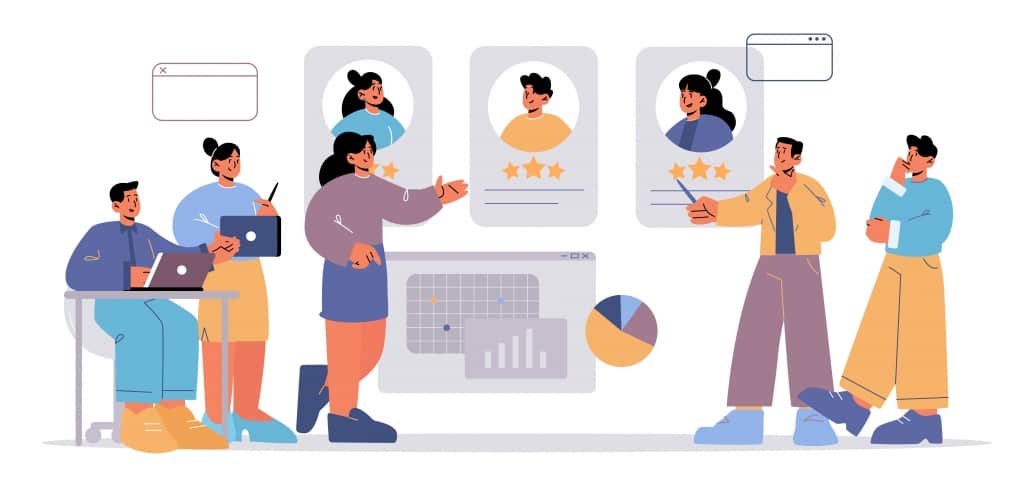Employee reviews are a critical aspect of any organization's human resource management. These reviews provide an opportunity for organizations to assess their employees' performance, provide feedback, and set goals for improvement.
However, conducting a successful review for employees can be a challenging task. Therefore, in this blog post, we'll explore some useful tips and examples to help you have a helpful review for employees.
More Work Tips with AhaSlides
- Employee Performance Evaluation
- Work Goals Examples for Evaluation
- Performance Evaluation Examples
- Self-appraisal examples
Table of Contents

What Is a Review for Employees?
An employee review is a process in which an employer evaluates an employee's performance over a period of time. It is an opportunity for organizations to share feedback about their employee, set goals, and identify employees' areas for improvement.
In addition, an employee review is critical for assisting employees in growing and developing in their roles, along with allowing employers to check that their team is meeting the organization's goals.
The review can also help create a positive and productive work environment by encouraging open communication and a culture of continuous improvement.

Tips For Conducting A Review For Employees Effectively
Here are some practical tips to help you conduct an effective review for employee:
1/ Define clear objectives and expectations - Review For Employee
By setting clear objectives and expectations, you and the employee can focus on what the review aims to achieve. This can help to ensure that the review is beneficial to both sides.
Here are some steps on how to set clear objectives for the review:
Define the purpose of the review
You need to start by answering the question "What is the purpose of this review?". Is it to evaluate employee performance over a specific period (3 months, 6 months, year-end), to identify areas for improvement, or to set goals for the future? Or all of the above? Communicate with employees so they can understand what the review is for.
Outline specific goals
Once you've defined the purpose of the review, outline the specific goals you want to achieve. These goals should be aligned with the goals of the organization and SMART (specific, measurable, achievable, relevant, and time-bound).
For example, an employee's performance review will have purpose and specific objectives like:
Purpose: To evaluate the employee's performance over the past six months and identify areas for improvement.
Specific objectives:
- Review the employee's performance over the past six months, including sales targets, customer satisfaction ratings, etc.
- Identify areas where the employee has excelled and areas where they may need additional support.
- Give constructive feedback on areas for improvement and collaborate with the employee to set actionable goals for the next 6 months.

Looking for an engagement tool at work?
Use fun quiz on AhaSlides to enhance your work environment. Sign up to take free quiz from AhaSlides template library!
🚀 Grab Free Quiz☁️
2/ Prepare in advance - Review For Employee
Once you have determined the objective of the employee review, you need to prepare information and data to have a comprehensive picture of the employee's performance.
- Review employee job descriptions: Review employee job descriptions to make sure that your evaluation aligns with their responsibilities and goals.
- Data collection: Collect all relevant employee data, such as productivity metrics, monthly reports, timekeeping records, and customer feedback. This information will help you identify employee strengths and weaknesses that need improvement.
- Review previous reviews: View previous employee reviews to determine where they've improved and where issues are recurring.
- Get feedback from others: Talk to your employees' colleagues, subordinates, or customers to gain insight into their performance.
- Set agenda: Create an agenda for the review, outline the key areas you want to discuss, and send it to the employee for them to prepare.
- Schedule a time and place: Make sure to schedule enough time to cover everything that needs to be discussed. And the review must take place in a comfortable and quiet location, free from distractions or interruptions.

3/ Provide specific examples - Review For Employee
By providing specific examples and specific information during the review, you can help employees understand exactly what they're doing well and what they need to improve on. You can respond as follows:
Use specific examples
Instead of generalizing, use specific examples to illustrate employee successes and areas for improvement.
- For example, if you want to highlight an employee's excellent communication skills, give specific examples of how they communicated effectively while speaking to customers, or collaborating with colleagues in other departments.
Use specific data
Whenever possible, use data to support your feedback.
- For example, if you're discussing with an employee about his sales record, you could provide specific numbers to compare. Such as their sales record is higher than the previous month, or the number of new customers they brought in, or their conversion rate.
Avoid ambiguous language
Avoid using ambiguous language when providing feedback.
- Instead of saying, "You need to be more productive," give specific examples of where employees could be more productive and how they could improve, such as "You should use a time management tool to avoid missing deadlines"
4/ Provide constructive feedback - Review For Employee
By providing constructive feedback, you can help employees grow and develop in their roles. This is a guide to giving constructive feedback:
- Focus on behavior, not the person: Remember that focusing on your employees' behaviors and actions, rather than their personality or personality, helps keep your feedback constructive and avoids any conflicts, personal attacks, or criticism.
- Use a supportive and respectful tone: Feeling supported and respected will help maintain a positive working relationship between you and your employees. In addition, it ensures that employees feel comfortable and motivated to improve.
- Provide Specific Feedback: As mentioned above, be specific when providing feedback and provide examples to illustrate your point.
- Provide actionable steps: Provide actionable steps for improvement, so employees know what specific steps they need to take to improve their performance.
- End on a positive note: End the feedback on a positive note, highlighting the employee's strengths and potential for improvement. It helps employees maintain motivation and a positive attitude toward change.
5/ Develop an action plan - Review For Employee
After identifying areas for improvement or setting new goals, you and the employee need to agree on an action plan for them. An action plan will need the following information:
- Identify specific actions: Break down the goals into specific actions that the employee can take to achieve them. These actions help to provide clarity and focus, making it easier for the employee to work towards their goals.
- Set timelines: Determine specific timelines for each action, which helps to create urgency and ensures that progress is being made toward the goals.
- Identify resources needed: Determine what resources the employee will need to achieve their goals. This could include training, mentorship, or additional support from colleagues or managers.
- Monitor progress: Monitor progress regularly to ensure that the action plan is working and adjustments can be made if needed.
This plan can be integrated with their personal development plan in some stages focusing on development at work.

6/ Recognize achievements - Review For Employee
Recognizing employee achievements is an essential part of conducting an effective review process. This can build morale and motivate employees to continue performing at a high level. Some tips for recognizing employee achievements are as follows:
- Be specific: When recognizing employee achievements, be specific about what they did well and why it is important. Employees might feel valued and appreciated for their contributions.
- Align achievements with goals: When recognizing achievements, align them with the goals set for the employee. This helps employees see that their efforts make a tangible difference in achieving the desired results.
- Celebrate success: Celebrating employee successes during the review process can be done through verbal recognition, written rewards, or other forms of prize and encouragement.
- Be sincere: When recognizing employee achievements, be sincere in your praise and appreciation.
7/ Encourage open communication - Review For Employee
Encouraging open communication during the review is essential to ensure that employees feel heard and valued. Here are some steps on how to encourage open communication:
- Create a safe and comfortable space: Create a safe and comfortable environment for the employee to express their feedback and ask questions. This helps to build trust and encourages open communication.
- Listen actively: Listen actively to what the employee is saying, without interrupting or judging them. They will feel heard and valued and encouraged to express their thoughts and feelings openly.
- Ask open-ended questions: Ask open-ended questions can help the employee provide more detailed feedback. It's a chance to facilitate a more meaningful conversation and encourages the employee to be more honest in the review.
8/ Follow-Up - Review For Employee
By following up regularly after the review, you can ensure that the employee is making progress toward their goals and that any issues are being addressed on time.
In addition, following up regularly after the review helps to create a culture of accountability and continuous improvement in the workplace.

Key Takeaways
Conducting a review for employee is an essential part of maintaining and developing a healthy and productive workforce. By following the tips we have discussed in this article, you can ensure that your review process is effective, fair, and beneficial to both the employee and the organization.
And don't forget to inspire and motivate your employees every day with premade templates from AhaSlides. Designing training programs, meeting agendas, kick-off project meetings, employee surveys, and MORE has never been so exciting. Well worth a try!
*Ref: Josh Bersin








